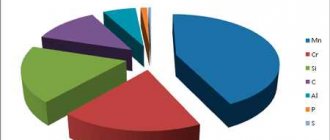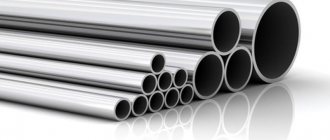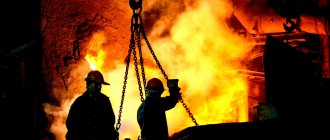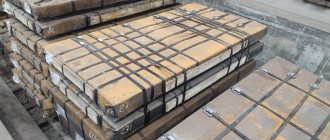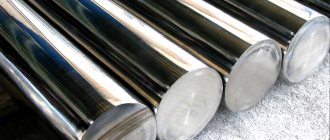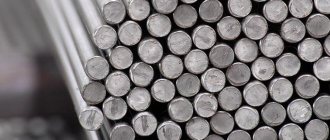Non-alloy steel alloy is the chemical term used to name two types of steel. Steel is a metal alloy. It is made up of iron and some other elements such as carbon. Unalloyed steels do not have elements added to the steel when it is remelted. Steel is widely used all over the world due to several reasons such as low cost, ease of manufacture, strength, etc. There are different grades of steel available according to their properties.
What is steel
An alloy based on iron (at least 45%) is called steel. Depending on the percentage of the second initial component - carbon, alloys are distinguished into high-carbon (0.6-2.14% C), medium-carbon (0.25-0.6% C), and low-carbon (no more than 0.25% C) . The higher this indicator, the more durable and elastic the steel, but at the same time with reduced ductility and impact resistance.
Alloy steel example
The required components of the alloy are deoxidizing agents - manganese and silicon. These chemical elements are present in small quantities and do not affect the properties. Their goal is to neutralize the harmful effects of oxygen.
Even high-quality steel contains harmful impurities that cannot be eliminated. This:
- sulfur, which causes cracks;
- phosphorus, which increases fragility (cold brittleness);
- nitrogen, oxygen, hydrogen – disintegrants of steel structure;
- oxides and nitrides leading to ruptures.
In addition to the listed components, carbon alloys always contain other substances that come along with the starting materials during smelting: copper, zinc, chromium, nickel, lead. The level of their content is so insignificant that they have neither a positive nor a negative effect.
Difference between alloy and unalloy steel
Definition
Alloy Steel: Alloy steel is a type of steel consisting of iron, carbon and some other elements.
Non-Alloy Steel: Non-alloy steel is a type of steel that has no other elements added during melting.
Presence of carbon
Alloy Steel: Alloy steel consists of a large amount of carbon.
Non-alloy Steel: Non-alloy steel has less or no carbon content.
smelting
Alloy Steel: Alloy steel is made by adding various elements during melting.
Properties and types of steels
Steel has the following properties:
- Physical: heat capacity, electrical and thermal conductivity, expansion when heated.
- Mechanical: strength, hardness, elasticity, plasticity, viscosity, endurance.
- Chemical: heat resistance, scale resistance, fire resistance, corrosion resistance.
To significantly change the properties of the alloy, alloying elements - other metals and non-metals - are introduced into the steel. This technology was created back in the 19th century. Steels are called alloyed if the proportion of each element is at least 0.1%.
Features of non-alloy steel products
Each type of steel has its own characteristics and it is important to initially understand under what conditions the casting will be used. This is the only way to create a high-quality, reliable casting that will meet all requirements.
Thus, non-alloy steel is one of the cheapest, but at the same time its quality can ensure reliable operation of many elements. Each grade of unalloyed steel has its own mechanical characteristics, which can be regulated by adjusting the amount of carbon in the metal itself.
If there is little carbon, the steel will be soft, but if hard, strong steel is needed, in addition to carbon, carburization can also be used, that is, the process of heat treatment of metal with a high carbon content.
Source
Differences
Alloyed steel differs from unalloyed steel in chemical composition. The first, in addition to iron and carbon, contains a large set of additional components that affect its properties. Carbon (classical) steel contains traces of random impurities that do not significantly affect its properties.
Other differences from conventional carbon alloys:
- resistance to corrosion and aggressive environments;
- sparking of metal if you bring it to the grinding wheel;
- there is low bearing capacity;
- higher production costs.
Main Difference – Alloy vs Unalloy Steel
Alloy and non-alloy steel are the chemical terms used to refer to the two types of steel. Steel is a metal alloy. It is made up of iron and some other elements such as carbon. Unalloyed steel has no elements added to the steel during smelting. Steel is widely used all over the world for several reasons such as low cost, ease of production, strength, etc. There are different grades of steel depending on their properties. Alloy steel is a type of steel and has a large number of other elements besides iron and carbon. The main difference between alloy and unalloy steel is that in alloy steel, other elements are added to the iron during smelting, whereas in unalloy steel, no elements are added during smelting.
Key areas covered
1. What is alloy steel - definition, properties 2. What is unalloy steel - definition, properties 3. What is the difference between alloy and unalloy steel - Comparison of the main differences
Key Terms: Alloy, Alloy Steel, Carbon, Chromium, High Alloy Steel, Intermediate Alloy, Iron, Metal, Unalloy Steel, Low Alloy Steel, Melt, Steel, Substitute Alloy
Alloying Additives
To alloy steels, chemical elements from different groups of the periodic table are used. Alloying metals (in Russian markings of alloys are designated by Russian letters) are introduced into the alloy to change the following characteristics:
- Nickel (N) – increases heat capacity, viscosity, ductility, reduces fragility, which is important for pressure treatment.
- Chrome (X) – increased hardness and impact resistance. Strong protection against corrosion, which is why there is a lot of chromium in stainless steel.
- Niobium (B) – improved acid resistance.
- Cobalt (K) – increased heat resistance, increased impact resistance.
- Copper (D) – increase in strength, but with a slight decrease in viscosity. Used primarily in construction steel.
- Titanium (T) and zirconium (Z) – reduction of grain size. The structure of the alloy becomes homogeneous, which reduces the likelihood of cracks.
- Tungsten (B) and molybdenum (M) - increased strength during heat treatment, resistance to rust.
- Aluminum (Au) – adding resistance to scale at high temperatures.
- Vanadium (F) – improved structure, increased heat resistance.
The list is supplemented by non-metallic additives:
- Manganese (G) – reducing the harmful effects of sulfur, phosphorus and oxygen.
- Silicon (C) – increases strength while maintaining viscosity.
- Selenium (E) – improves fluidity, facilitates machining of steel parts.
- Boron (P) – improvement of microstructure, increase in hardenability.
- Nitrogen (A) – improvement of mechanical properties, used in high-alloy steels.
Non-alloy steel - products and uses
Non-alloy steel castings are used depending on the grade of steel - it can be:
- 25L - most often these are products that will be used in the future under pressure or at high temperatures;
- 30L – products and spare parts that will be used in the future with vibration or under heavy loads;
- 35L - most often these are gears and valves that are supposed to be used under loads or with vibration;
- 40L – products that operate in chain drives, for example, brake discs;
- 45L - products that operate in chain drives, for example, brake discs, but which are subject to increased requirements for strength, wear resistance under conditions of increased loads and vibration;
- 55L – gear products, couplings and other products that must have high hardness values.
Explanation of steel markings
To determine the steel grade, a special designation has been developed in accordance with GOST 4543-71. It is based on numbers and letters. The first letter shows which group of steels the alloy belongs to. For example:
- I am chromium-nickel stainless steel;
- A – automatic steel;
- F – stainless steel;
- E – magnetic steel;
- R – high-speed;
- Ш – ball bearing;
- ШХ – ball-bearing chromium steel.
If the letter is missing, this means it belongs to a classic alloy using additives.
The first digit in the marking indicates hundredths of the percentage of carbon content. Next come letters and numbers indicating alloying additives and their content, also in percentages. For example, the marking X5X18N10 should be read as follows: chromium steel containing 0.05% carbon, 18% chromium, 10% nickel. In English, the marking looks different: X5CrNi18-10.
Other examples:
- EX9K15M. Means: magnetic chromium steel, contains 0.09% carbon, 15% cobalt, no more than 1% molybdenum.
- 38ХН3МФ: 0.38% carbon, less than 1% chromium, 3% nickel, molybdenum and vanadium not more than 1%.
The percentage of additives is written in whole numbers, without tenths and hundredths.
At the end of the marking (on the right) there may also be letters: A - high-quality steel, Ш - especially high-quality steel. Other letters indicate the production method: TO (T) - heat-treated, H - cold-worked rolled steel.
Types of non-alloy steel
Non-alloy steel can be of the following types:
- For railway casting – these are switches, rails, as well as other products for creating railway tracks. Wheels and axles are also manufactured, that is, all structures that have high reliability requirements;
- Steel 10895 - most often such parts are used in magnetic circuits for electrical devices. This is a fairly ductile steel that can be processed in a hot state;
- Carbon non-alloy steel;
- High carbon steel;
- Medium carbon;
- Low carbon.
Carbon-containing steels are among the most affordable in terms of cost, because their composition is very simple and does not require the use of any expensive ferroalloys.
Classification of alloy steels
Classification and marking of alloy steels is carried out according to several parameters.
By quality
Depending on the amount of harmful impurities (sulfur, phosphorus), alloy steels are high-quality (S≤0.04%, P≤0.035%), high-quality (S≤0.025%, P≤0.025%), especially high-quality: (S≤0 .06%, P≤0.07%).
By number of additives
Depending on the total amount of additives, the following types of alloy steel are distinguished:
- High alloy steel: 10-50% alloying additives. The products are the most durable, but also the most expensive.
- Medium alloyed: 2.5-10% additives. These are the most popular brands.
- Low alloy: additives no more than 2.5%. Positive qualities improved, but did not noticeably affect metalworking.
Depending on the chemical composition, steels are called: chromium, chromium-nickel, chromium-nickel-molybdenum, manganese and others. In the marking they are indicated by the corresponding letters.
By purpose
According to practical application, steels are classified into structural (machine-building, construction, improvement, cemented), tool (for dies, cutting and measuring tools) and with special properties.
Non-alloy steel
Unalloyed steel is a mixture of almost only iron. Due to its composition, this alloy lends itself well to heat treatment, which is why various tools are most often made from it.
Such tool steel is also used for the production of housings, nails, cutters, bolts, as well as other fasteners and cutting tools. Most often, this type of steel is produced in open hearth furnaces, and products made from it can withstand temperatures of up to 450 degrees Celsius.
Composition and application of alloy steels
The use of alloys is determined by their chemical composition. Thus, construction low-alloy steels are used for metal structures with a uniformly distributed load between all elements. The only requirement is good weldability.
Types of structural steels:
- Improved, high chromium content, enriched with boron, nickel, molybdenum, manganese. Designed for heat treatment.
- Spring-spring. These alloys are alloyed with silicon, cobalt, manganese, boron, and titanium. Used in the production of transport.
- Bearing. They have increased hardness and wear resistance. Be sure to contain chromium and a minimum of non-metallic additives.
- Heat resistant. Used for the production of steam heaters.
Tool steels for milling cutters, cutters, and taps are alloyed with chromium, vanadium, titanium and other additives. These are very expensive high-speed alloys, so they are used only in cutting planes. For measuring instruments, steel is alloyed with chromium, tungsten and manganese. This ensures hardness and retention of original dimensions.
Steels with special properties:
- Highly durable. These are high-alloy steels with a specially selected composition. They are used for the manufacture of critical components of mechanisms.
- Stainless steel, with additions of manganese and chromium. Used for work in chemically aggressive environments. Used to make pipes.
- Wear-resistant, high manganese content. They are used to make railway switches, tracks, mining equipment, and excavator buckets.
This group also includes heat-resistant, heat-resistant, magnetic, non-magnetic, rheostatic, and high electrical resistance alloys.
Non-alloy tool steels
Corrosion-resistant martensitic steels20Х13
| AISI | ||
| 20Х13 | X20Cr13 (1.4021) | 420 |
General characteristics:
steel belongs to the martensitic class of the hypoeutectoid group.
After hardening it has a martensite structure. Welds satisfactorily. The greatest corrosion resistance of steel is achieved by heat treatment: hardening, tempering and polishing. Application:
facing and structural parts for devices operating in hot environments containing sulfur dioxide;
parts of increased ductility exposed to shock loads. Types of supplied products:
rolled round (8-160 mm), square (28-200 mm) sections, turned rods and with special surface finishing up to a circle of 70 mm, forged and rolled strip, sutunka.
Delivery condition:
annealed with a hardness of 126-197 HB; heat treatment: hardening from 1000-1050°C, cooling in air or oil; tempering at 660-770°C, cooling in air, oil or water
1.4021
| DIN 17440 |
| X20Cr13 |
Types of supplied products:
blooms, blanks sq. 100-120 mm, turned rods sq. 12-200 mm (with maximum deviations from the diameter - half the total tolerance according to DIN 1013);
bars 6-120 mm with polished surface h 10 - h13 or k 10 - k 13. Delivery condition:
annealed (A) - annealing at 730-780°C, cooling in a furnace or in air, hardening at 980-1030°C, cooling in air or oil; improved (QT700) - tempering at 650-750°C; improved (QT800) - tempering at 600-700°C.
40Х13
| GOST 5632-72 | DIN 1.4031 |
| 40Х13 | X38Cr13 |
General characteristics:
steel belongs to the martensitic class, which allows it to obtain high hardness after hardening and be used as a wear-resistant and elastic material.
Steel is not used for welded structures. Application:
after hardening and low tempering with a ground and polished surface - cutting, measuring and surgical instruments, springs, carburetor needles, household items.
In the condition after high tempering - bushings, axles, shafts, springs, springs, housings, axles, blades, tires of steam turbines; disks operating at temperatures up to 400-450°C; bolts, nuts and other parts operating in corrosive environments. Types of supplied products:
rolled round (8-200 mm), square (28-200 mm) sections, turned rods and with special surface finishing up to edge 70 mm, forged and rolled strip, sutunka.
Delivery condition:
annealed.
95Х18 (EI229)
| GOST 5632-72 |
| 95Х18 (EI229) |
General characteristics:
the steel belongs to the martensitic class with a high content of carbon and chromium.
It is highly resistant to alkaline solutions, nitric and acetic acids. The maximum hardness when quenched with oil cooling is 57-59 HRC. Density at 20°C - 7.75 10? kg/m?; thermal conductivity - 0.243·102 W/(m°C); specific heat capacity - 0.483·10? J/(kg°C) at 20-100°C. Beginning of intense oxidation at 750°C. Application:
Premium quality, corrosion-resistant bearings for oilfield equipment, bushings and other parts subject to heavy wear.
Types of products supplied:
rolled and forged products, round (8-160 mm), square (80-160 mm) blanks;
turned, ground rods with a diameter of 12-70 mm, steel with a special surface finish. 1.5-47 mm. Delivery condition:
heat treatment - hardening from 1000-1050°C, cooling in air or oil; tempering at 200-300°C, cooling in air or oil.
40Х9С2
| GOST 5632-72 | DIN | AISI/SAE |
| 40Х9С2 | X45CrSi 9-3 (1.4718) | HNV3 |
General characteristics:
heat-resistant and heat-resistant martensitic steel.
The temperature at which intense scale formation begins is 850°C. Resistant in sulfur-containing environments. Density at 20°C - 7.63 10? kg/m?. Application:
intake and exhaust valves for automobile and tractor engines, recuperator tubes, heat exchangers, grate bars.
Types of products supplied:
long products with round, square and strip sections;
calibrated rods. Delivery condition:
in annealed condition with a hardness of no more than HB 269.
20Х13Н4Г9
| GOST 5632-72 | DIN |
| 20Х13Н4Г9 | X2CrMnNiN17-7-5 (1.4371) |
General characteristics:
steel provides high performance properties in equipment for creating deep cold.
Prone to work hardening, the structure after quenching (1120-1150°C in water) consists of austenite and martensite with a predominance of the austenitic component. Heat treatment of metal at temperatures of 400-800°C promotes the release of Cr23C6 carbides, which, located predominantly at grain boundaries, reduce impact toughness. It is corrosion resistant in atmospheric conditions up to 800°C. Application:
serves as a substitute for cold-rolled steel grades 12Х18Н9 and 17Х18Н9.
Used for lightweight and durable structures connected by electric spot welding. When using other types of welding (gas, electric arc, argon-arc), welded joints are susceptible to intergranular corrosion. Types of products supplied:
forged grade and round, square blanks 80-200 mm.
Delivery condition:
turned, ground rods and with special surface finishing.
25Х13Н2
| GOST 5632-72 |
| 25Х13Н2 |
General characteristics:
martensitic steel, high corrosion resistance.
The macrostructure of cast metal is with a small amount of alpha phase located along the grain boundaries. In deformed metal, the nature of the structure is preserved, the grain is fine, sulfides are located along the fiber. Application:
due to its good ductility, it is used for the manufacture of parts on automatic machines that operate in aggressive environments - hydraulic press valves, household items.
Types of products supplied:
rolled steel O8-75 mm, forged grade 80-200 mm, turned rods O12-70 mm, rods with special surface finishing O1.5-47 mm (also in accordance with TU 14-1-721-73)
Delivery condition:
annealed.
14Х17Н2 (EI268)
| GOST 5632-72 | DIN | AISI/SAE |
| 14Х17Н2 (EI268) | X20Cr17Ni2 (1.4057) | 431 |
General characteristics:
corrosion-resistant and heat-resistant martensitic steel: weldable to a limited extent, has the greatest corrosion resistance after quenching with high tempering.
Density at 20°C - 7.7x10? kg/m? Application:
used as steel with fairly satisfactory technological properties in the chemical, aviation and other industries - working blades, disks, shafts, bushings, flanges, fasteners and other parts of compressor machines operating in gas.
Welded joints in the heat-affected zone have reduced resistance to MCC and general corrosion, therefore, after welding, tempering is required at 680-700°C for 30-60 minutes. Welding method: manual arc. Types of products supplied:
long products of round, square and rectangular sections, calibrated bars.
Delivery condition:
annealed: hardness no more than HB 285.
Ferritic corrosion steels
12Х17
| GOST 5632-72 | DIN | AISI/SAE |
| 12Х17 | X6Cr17 (1.4057) | 430 |
General characteristics:
steel is corrosion-resistant and heat-resistant up to 850°C, ferritic class.
Weldability is satisfactory. Heat resistance—temperature of intense scaling in air is 900°C. Density at 20°C - 7.7x10? kg/m? Application:
products operating mainly in oxidizing environments: household items and kitchen utensils;
equipment for food and light industry factories; adsorption towers, heat exchangers for hot nitrous gases and hot nitric acid, fasteners, rolls, bushings, etc.; parts of apparatus and vessels operating in dilute solutions of nitric, acetic, and citric acids; in solutions of salts with oxidizing properties. Recommended as a substitute for steel 12Х18Н9. Types of supplied products:
rolled bars with round (O8-150 mm), square (28-200 mm) sections, calibrated steel, turned and ground rods with special surface finishing.
Delivery condition:
annealed: hardness 126-197 HB.
Corrosion steels, austenitic
08Х18Н10Т
| GOST 5632-72 | DIN | AISI/SAE |
| 08Х18Н10Т | X6CrNiTi18.10 (1.4541) | 321 |
General characteristics:
corrosion-resistant and heat-resistant austenitic steel.
Steel in a hardened state is not prone to intergranular corrosion (ICC). After heating in the temperature range of 600-650°C, it may acquire a tendency to MCC. It welds well with all types of welding. Density at 20°C - 7.9x10?3 kg/m? Application:
recommended for the manufacture of welded products in highly aggressive environments: in solutions of nitric, phosphoric, acetic acids: in solutions of alkalis and salts.
Heat exchangers, forgings of power equipment, fasteners with operating temperatures up to 600°C. Types of supplied products:
long rolled products with round (O12-200 mm), square (28-200 mm square) sections, turned rods and with special surface finishing, forged and rolled strip, sutunka.
12Х18Н10Т
| GOST 5632-72 |
| 12Х18Н10Т |
General characteristics:
corrosion-resistant steel of austenitic class.
It has high strength and resistance to knife corrosion in welded joints. Application:
used for the manufacture of welded equipment in various industries.
Types of products supplied::
rolled round (O8-160 mm), square (28-200 mm square) sections, turned rods and with special surface finishing, forged and rolled strip, sutunka.
10Х17Н13М2Т (EI448)
| GOST 5632-72 | DIN | AISI/SAE |
| 10Х17Н13М2Т | X6CrNiMoTi17.122 (1.4571) | 316Ti |
General characteristics:
corrosion-resistant steel of austenitic class.
It can be stamped well and is not prone to intergranular corrosion. Density at 20°C - 7.9x10? kg/m? Application:
recommended for the manufacture of welded structures operating in boiling phosphoric, sulfuric, 10% acetic acid and sulfuric acid environments, parts of turbines, compressors, welding wire.
Types of supplied products:
rolled round (O12-160 mm), square (28-200 mm square) sections, turned rods and with special surface finishing, forged and rolled strip, sutunka.
1.4571
| DIN 17440 | GOST 5632-72 | ASTM-479 |
| 1.4571 (X6CrNiMoTi 17.122) | 10Х17Н13М2Т | 316Ti |
Types of supplied products:
square billet, turned bars sq. 12-160 mm, bars with special surface finishing with maximum deviations h10-h12 edge 1.5-70 mm
Delivery condition: billet - without heat treatment; rods are in a hardened state.
Features of alloy steel - varieties, application
In the modern world there are a large number of varieties of steel. This is one of the most popular materials, which is used in almost all industries.
What is alloy steel
This is carbon steel, to improve its technological properties, special alloying elements have been introduced. The percentage of additives in the composition is small, but even with a small concentration, the physical properties of the metal improve several times.
Depending on the type of additives used in steel production, the metal acquires the following properties:
- resistance to corrosion;
- elasticity;
- infusibility;
- strength.
To impart the listed qualities, the following metals are added to the composition:
Often, it is enough to add 1 - 3% alloying elements to carbon steel to give it the necessary properties and qualities.
How to decipher steel grade
Alloy (stainless) steels
, unlike unalloyed ones, have a slightly different designation, since they contain elements that are specially introduced in certain quantities to provide the required physical or mechanical properties. Eg:
- chromium (Cr) increases hardness and strength
- Nickel (Ni) provides corrosion resistance and increases hardenability
- Cobalt (Co) improves heat resistance and increases impact resistance
- Niobium (Nb) helps improve acid resistance and reduces corrosion in welded structures.
That is why it is customary to include in the names of alloy steels the chemical elements present in the composition and their percentage content. Chemical elements in such steel grades are designated by Russian letters given in the table.
| X-chrome | A-nitrogen |
| C-silicon | N-nickel |
| D-copper | M-molybdenum |
| T-titanium | K-cobalt |
| B-tungsten | B-niobium |
| G-manganese | E-selenium |
| F-vanadium | C-zirconium |
| R-boron | U-aluminum |
There is also a marking H, which tells us that the alloy contains rare earth metals, such as cerium, lanthanum, neodymium and others. Cerium (Ce) affects the strength and ductility of steel, and neodymium (Nd) and lanthanum (La) reduce porosity and sulfur content in steel and refine the grain.
Difference between Low Alloy Steel and High Alloy Steel
The main difference between Low Alloy Steel and High Alloy Steel is that Low Alloy Steels contain less than 0.25% alloying element whereas High Alloy Steels have more than 10% alloying element . In addition to dividing into low-alloy and high-alloy steel, it is also divided according to the degree of alloying into medium-alloy. In this steel, the amount of alloying elements ranges from 2.5 to 10%)
An alloy is a mixture of two or more elements. It is produced by mixing molten metal with some other elements (metals or non-metals or both) to produce a material that has improved properties over the original metal. Low alloy steel and high alloy steel are two types of iron alloys with alloying elements. The most popular alloying elements in these steels are: nickel (Ni), copper (Cu), titanium (Ti) and vanadium (V), nitrogen (N), etc.
Content
- Overview and main differences
- What is Low Alloy Steel
- What is High Alloy Steel
- What is the difference between Low Alloy Steel and High Alloy Steel
- Conclusion
What is Low Alloy Steel?
Low alloy steel is a type of alloy steel whose properties are improved compared to carbon steel. For example, this alloy has better mechanical properties and greater corrosion resistance than carbon steel. The carbon content of low alloy steel is less than 0.2%. The most common alloying elements in this steel are: Nickel (Ni), Chromium (Cr), Molybdenum (Mo), Tungsten (V), Boron (B), Tungsten (W) and Copper (Cu).
Sheet steel
In most cases, the manufacturing process of these alloy steels includes heat treatment and tempering (for normalization). But now, there is a tendency to harden and temper. In addition, almost all low alloy steel materials are weldable. However, the material sometimes requires treatment before or after welding (to avoid cracking).
Some advantages of low alloy steel:
- Yield strength is higher
- High tensile strength
- Higher resistance to oxidation and corrosion
- Low cold brittleness threshold
This material is used in industry, but up to a maximum temperature of 580 °C. If the temperature is higher than 580 °C, this material is not suitable due to lack of sufficient oxidation resistance to cope with high temperatures.
What is High Alloy Steel?
High alloy steel is a type of alloy steel that contains more than 10% alloying elements. Unlike low alloy steel, the alloying elements for high alloy steel are chromium (Cr) and nickel (Ni). The most famous example of this steel is stainless steel.
Stainless steel pan
Chromium provides steel with a thin oxide layer on the surface of the steel. This is called the hidden layer because this layer retards corrosion of the metal. In addition, manufacturers typically add large amounts of carbon and manganese to give the steel its austenitic character. In addition, this material is more expensive than low alloy steel.
What is the difference between Low Alloy Steel and High Alloy Steel?
Both low-alloy and high-alloy steel have improved properties than carbon steel. However, the key difference between low alloy steel and high alloy steel is that low alloy steels contain less than 0.25% alloying elements, while high alloy steels contain more than 10% alloying elements. In the chemical composition, low alloy steel contains iron, carbon (less than 0.2%) and other alloying elements such as Nickel (Ni), Chromium (Cr), Molybdenum (Mo), Tungsten (V), Boron (B), Tungsten ( W) and Copper (Cu), while high alloy steel contains iron, chromium, nickel, carbon, manganese, etc.
Conclusion – Low Alloy Steel vs High Alloy Steel
Both low-alloy and high-alloy steel have improved properties than carbon steel. The main difference between Low Alloy Steel and High Alloy Steel is that Low Alloy Steels contain less than 0.25% alloying elements whereas High Alloy Steels have more than 10% alloying elements.
Alloy steels
Alloy steels are alloys whose properties are improved by adding additional components called alloying components. Their use is driven by the desire to achieve different properties from the resulting raw materials that are necessary in different situations.
This alloy has increased strength and does not corrode longer. The areas of its application are quite diverse. Basically, these are pipes, parts and other products that will be subject to increased temperature changes during operation.
The composition of ordinary metal includes iron, carbon and various impurities. When doping, as mentioned earlier, other components are added to it, called alloying components. Among them: niobium, chromium, nickel, silicon, vanadium, etc. Aluminum and molybdenum are also often found. To increase the strength of the resulting raw material, titanium is often added.
Steel grades with special properties
We bring to your attention a wide range of rolled products from alloy steels with special properties: electrical, relay, scale-resistant, stainless, acid-resistant, hard magnetic and soft magnetic steels. Steels acquire “special properties” due to the introduction into them during the manufacturing process of a certain amount of a certain substance, called an alloying element. Alloying elements can be aluminum, manganese, etc.
The range of metal products meets the requirements:
- round rolled products - GOST 2590-88, GOST 7417;
- square rolled products - GOST 2591-88, GOST 8559;
- hexagonal rolled products - GOST 2879-88, GOST 8560;
- forged square and round rods - GOST 1113-88;
- stripes - GOST 103-76, GOST 4405;
- with special surface finishing - GOST 14955.



